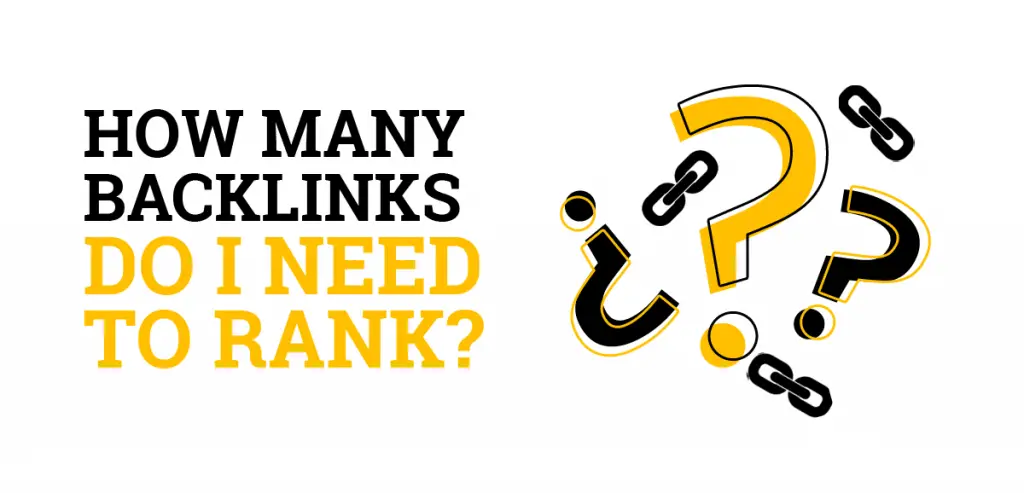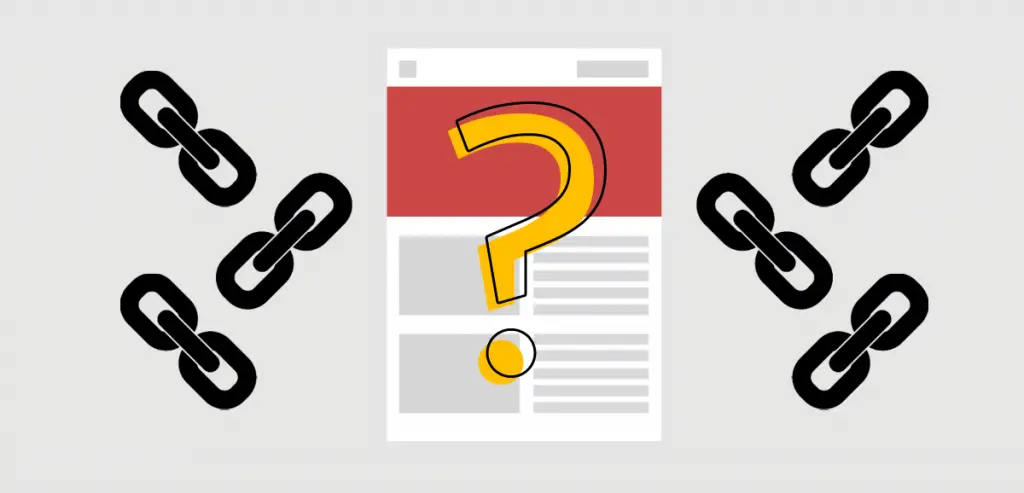In this article, we’ll answer the question, “how many backlinks do I need to rank?”
As you’ll discover below, the answer for how many backlinks should a website have depends on several internal and external search engine optimization (SEO) factors.
However, the ultimate goal here is to give you a definitive answer for how many backlinks do you need to rank on Google so you can walk away with a solid SEO strategy for your website.
By the end, you’ll understand how to achieve better ranking results with fewer backlinks than you may have thought.

How Many Backlinks Do I Need to Rank?
You need 0 to 25 backlinks to rank for low competition keywords and 50 to 100 backlinks for high competition keywords on average. However, the exact number of backlinks you need to rank a web page depends on your website’s domain authority and the PageRank of the incoming backlinks.
We’ll get into the specifics of how many backlinks do you need to rank in the second half of this guide. But for now, let’s break this question down into two important parts:
- How many backlinks should a website have for the homepage.
- How many backlinks should each page have.
How Many Backlinks Should a Website Have?
A website should have 40 to 50 backlinks to the homepage on average to increase the domain authority to a competitive level for SEO. However, the PageRank scores of those backlinks are important because the higher their value, the fewer links are needed to boost overall rankings.
Now, keep in mind that this range is just an average for good SEO and you don’t always need that many backlinks to compete in the search engine results pages (SERPs). For example, getting a single PR10 backlink from a website with extremely high authority is much more valuable for SEO and rankings than three PR5 backlinks from lower authority sites.
Your goal for long-term keyword competitiveness and higher rankings should be to acquire the highest PageRank backlinks you can get. Quality is always better than quantity when it comes to building backlinks. See this article on how to create high quality backlinks if you need ideas for link building.
How Many Backlinks Should Each Page Have?
Each page should have 0 to 100 backlinks to rank in the SERPs for its target keywords. The website domain authority, keyword difficulty level, and the number of internal links will determine the exact quantity of backlinks each page should have to rank high in the search engines.
Domain Authority Impact
There are numerous SEO tools that report some form of domain authority for a website. The most common are Moz, Ahrefs, and Semrush.
Domain Authority (DA) is an SEO metric first developed by Moz that measures the overall strength of a domain. Domain Rating (DR) is Ahrefs version of DA that shows the power of a website’s backlink profile. And Authority Score (AS) is Semrush’s adaption of DA for measuring the overall quality and SEO performance for a website.
DA, DR, and AS are all rated on a 100-point scale, with the higher numbers indicating a stronger domain with the probability of achieving better results in the SERPs.
With all things being equal in regards to content quality, matching user search intent, on-page SEO, and technical SEO, a website with a higher domain authority should rank higher in Google for a target keyword. (But this is not always true as you’ll see in the next section about keyword difficulty.)
The reason that would happen is because Google’s algorithm takes into account off-page SEO factors like backlinks to determine where a website should rank in the index. And a site with a higher domain authority has more demonstrated trust on the Internet because there are high quality sites casting votes (i.e., backlinks) for the homepage, or a single web page, by linking to it.
Keyword Difficulty Impact
Keyword difficulty is another metric that SEO tools use to estimate how difficult it could be to rank a web page for a target keyword. And like domain authority, it’s based on a 100-point scale, with the higher numbers indicating tougher competition.
There are four factors that influence keyword difficulty score, including:
- Domain Authority: The strength of the overall domain.
- Page Authority: The strength of the individual web page.
- Citation Flow: The quantity of backlinks to the individual web page.
- Trust Flow: The quality of the backlinks to the individual web page.
As you can see, domain authority is just one element for estimating how tough it may be for you to rank a web page in the SERPs for a keyword phrase. Metrics like citation flow and trust flow are also important because it’s not just the quantity of backlinks that are important, but the quality of those incoming links as well.
It’s common for a high DA site to be outranked by a lower DA site just because it has better quality backlinks to the individual web page. Also, there’s one other thing these SEO metrics do not take into consideration when judging a URL: the quality of the on-page SEO.
For some keywords, on-page SEO can outweigh the number of backlinks a web page has because it gives Google’s algorithm the correct signals it needs to rank the content for a set of keywords. Off-page SEO like backlinks are not always the most powerful SEO ranking factor, especially when on-page SEO is optimized well on the page.
The truth is a website can rank in the top 10 positions on Google for its target keywords without having a single backlink to the individual web page when you focus on good on-page search engine optimization. To learn more about how to do use the power of on-page SEO like this, check out this article on how to add keywords to a website for SEO.
Also, give this list of free backlink checker tools a look if you want to scan your website’s link profile without paying for it.
Internal Linking Impact
Another factor that impacts how many backlinks each page should have is the number of internal links a page receives.
There have been many SEO case studies by experts like Spencer Haws and Kyle Roof that prove internal links can increase the rankings for a web page in the SERPs. SEO testing indicates that 3 internal links are equal to 1 external backlink on average.
Google even reports that the more internal links a page has, the more important you’re telling the search engine crawler it is for the user. And therefore, the page should be given higher visibility in the SERPs.
The SEO technique you need to use here is to include keyword-rich anchor text when linking internally to the target page. You also want to link from other relevant content on the site and not just randomly because the annotation text surrounding the internal link can also be considered by Google’s indexing algorithm.
Achieving More With Less Backlinks
To bring everything you learned in this article together so you can walk away with a good SEO strategy for building backlinks, here’s some takeaway advice for how to achieve better ranking results with fewer backlinks:
- Choose at least 3-5 keywords to optimize the page for and pick terms with low keyword difficulty scores.
- Do the best on-page SEO possible by putting your keywords in the right HTML locations for Google to crawl.
- Make sure your content satisfies the user search intent. Look at the top-ranking sites in Google for your main keyword phrase to understand what type of content is being rewarded so you can create something similar.
- After publishing the article, create at least 5 contextual internal links to the page with keyword-rich anchor text.
- Link to the web page from your homepage if you can. The homepage typically passes the most internal PageRank value.
- Work on building more high quality backlinks to the homepage to increase the overall domain authority rather than individual pages. Use one of these top link building services if you need help with this SEO task.
Following the above strategy will give your web pages the best chance possible for ranking high in the SERPs for your target keywords. And in many cases, you can achieve top 10 rankings without building a single backlink to the web page.
However, there may be some tougher competition keywords that do require more backlinks to rank high in the SERPs. Once you’ve done everything you can to maximize the strength of the SEO factors you can control on your site, then, and only then, should you look to get more backlinks to an individual web page.
You may find that you need fewer backlinks than you imagined to rank for your keywords after you’ve optimized the web page and internal SEO signals correctly. And if you’re wondering how many backlinks per day is safe to create, then check out that linked article for the answer.

How Many Backlinks Do You Need to Rank Summary
I hope you enjoyed this guide answering the question about how many backlinks do I need to rank on Google.
As you discovered, the answer for how many backlinks should a website have depends on a number of factors, including the domain authority, page authority, citation flow, and trust flow of the incoming links.
However, the backlink metrics are only one part of the ranking puzzle. You can often achieve good results in the SERPs by doing a better job at on-page SEO and internal linking than your competitors.

SEO Chatter is dedicated to teaching the fundamentals of search engine marketing to help marketers understand how to increase organic website traffic and improve search engine rankings.
